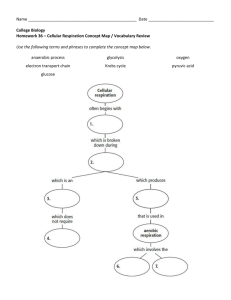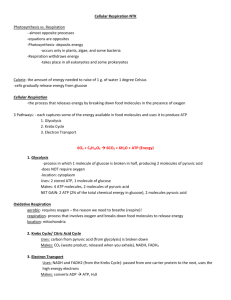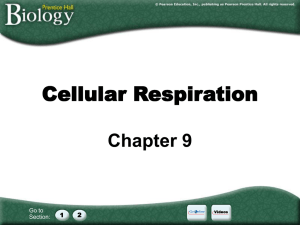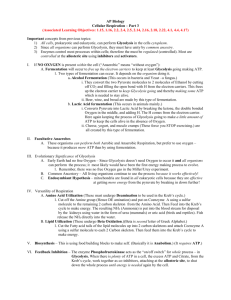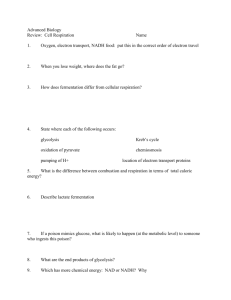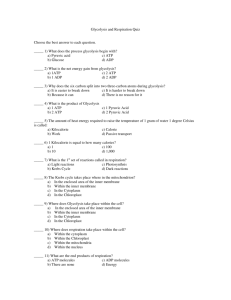Biology 7th hour Chapter 6 Krebs Cycle and Fermentation Quiz
advertisement
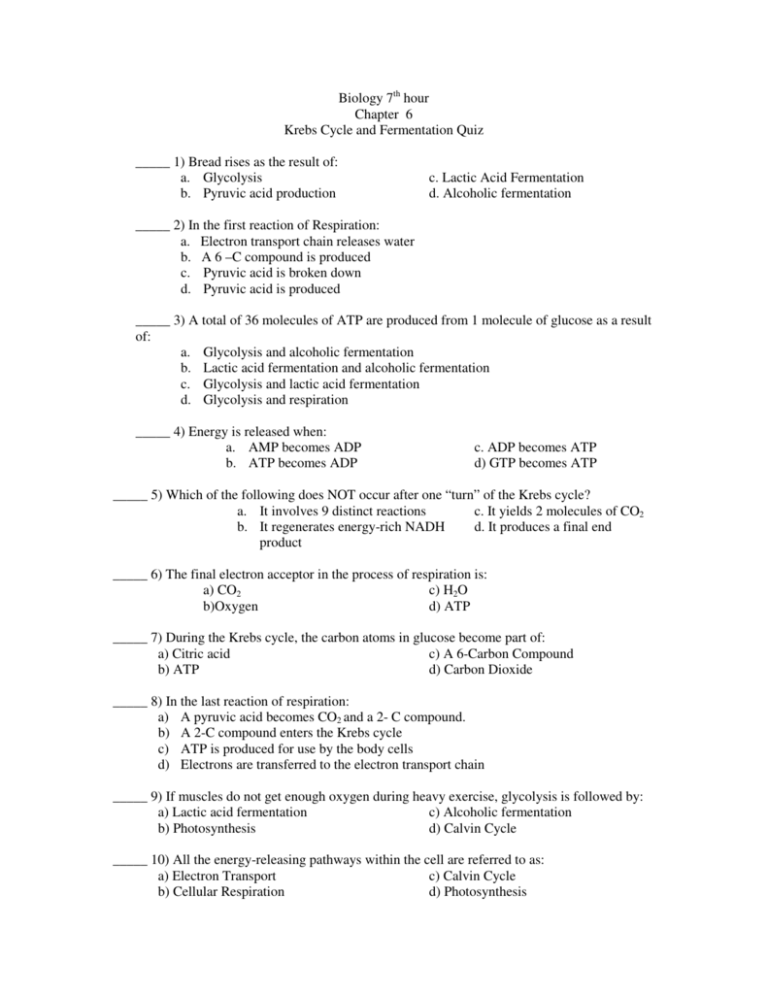
Biology 7th hour Chapter 6 Krebs Cycle and Fermentation Quiz _____ 1) Bread rises as the result of: a. Glycolysis b. Pyruvic acid production c. Lactic Acid Fermentation d. Alcoholic fermentation _____ 2) In the first reaction of Respiration: a. Electron transport chain releases water b. A 6 –C compound is produced c. Pyruvic acid is broken down d. Pyruvic acid is produced _____ 3) A total of 36 molecules of ATP are produced from 1 molecule of glucose as a result of: a. Glycolysis and alcoholic fermentation b. Lactic acid fermentation and alcoholic fermentation c. Glycolysis and lactic acid fermentation d. Glycolysis and respiration _____ 4) Energy is released when: a. AMP becomes ADP b. ATP becomes ADP c. ADP becomes ATP d) GTP becomes ATP _____ 5) Which of the following does NOT occur after one “turn” of the Krebs cycle? a. It involves 9 distinct reactions c. It yields 2 molecules of CO2 b. It regenerates energy-rich NADH d. It produces a final end product _____ 6) The final electron acceptor in the process of respiration is: a) CO2 c) H2O b)Oxygen d) ATP _____ 7) During the Krebs cycle, the carbon atoms in glucose become part of: a) Citric acid c) A 6-Carbon Compound b) ATP d) Carbon Dioxide _____ 8) In the last reaction of respiration: a) A pyruvic acid becomes CO2 and a 2- C compound. b) A 2-C compound enters the Krebs cycle c) ATP is produced for use by the body cells d) Electrons are transferred to the electron transport chain _____ 9) If muscles do not get enough oxygen during heavy exercise, glycolysis is followed by: a) Lactic acid fermentation c) Alcoholic fermentation b) Photosynthesis d) Calvin Cycle _____ 10) All the energy-releasing pathways within the cell are referred to as: a) Electron Transport c) Calvin Cycle b) Cellular Respiration d) Photosynthesis _____ 11) Glycolysis is considered what type of reaction: a) Aerobic b) Anaerobic _____ 12) Fermentation is considered what type of reaction: a) Aerobic b) Anaerobic _____ 13) Cellular Respiration is considered what type of reaction: a) Aerobic b) Anaerobic _____ 14) Every time that ADP becomes ATP what occurs: a) Energy is released c) Energy does not change b) Energy is lost d) Energy is stored _____ 15) When 2 H and 2 e- are sent to NAD they are actually being sent to: a) The dark reactions c) The light reactions b) The Electron Transport chain d) Glycolysis For the following cycles you need to fill in the blanks with the correct answers. Pyruvic Acid Pyruvic Acid | | Active Acetate C2 H3O – CoA | | Active Acetate C2 H3O – CoA Oxaloacetic Acid C4H4O5 + C2 H4 O2 Malic Acid (C___H___ O___) Fumaric Acid (C___ H___ O___) Succinic Acid (C4H6O4) Oxaloacetic Acid C4H4O5 + C2 H4O2 Citric Acid C__ H___ O___ - Ketoglutaric acid ( C___ H___ O___)

